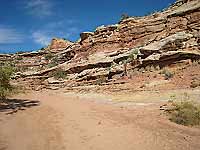 If this fragmented, hard-to-find road could talk, it would transport me back to another era when paved highways and fast moving vehicles didn’t exist. A reminiscent story would be told about how traveling into the backcountry took days, not hours. I would hear how anyone venturing this far from civilization stayed put for a while, as racing back to town was not an option. In the North Fork of Seven Mile Canyon this road would also tell me that cowboys often traveled over its sandy base, many of them on their way to spend a solitary length of time herding cattle. Within these curvaceous walls, so much history has passed by, so many wild tales left behind. If this fragmented, hard-to-find road could talk, it would transport me back to another era when paved highways and fast moving vehicles didn’t exist. A reminiscent story would be told about how traveling into the backcountry took days, not hours. I would hear how anyone venturing this far from civilization stayed put for a while, as racing back to town was not an option. In the North Fork of Seven Mile Canyon this road would also tell me that cowboys often traveled over its sandy base, many of them on their way to spend a solitary length of time herding cattle. Within these curvaceous walls, so much history has passed by, so many wild tales left behind.
There are two major forks at the beginning of Seven Mile – the North Fork and the South Fork. Both of them are easily accessible from Highway 313. The North Fork, with its intriguing history is a hiker’s delight that is a quick, scenic drive from Moab. To get there, go north on Highway 191 for approximately nine miles and turn left on to Highway 313. Then drive three more miles and park at a pullout on the right before the cattle guard, just before the switchbacks that climb out of the canyon.
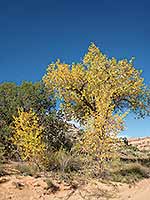 Kayenta Sandstone is the building block of these canyon walls. Exquisitely rounded and layered, they flow with a pleasing, gentle grace that creates an entirely different sensation from the awesome power of the sheer walls of Navajo and Wingate Sandstone. To make the descent to the wide belly within this elegantly designed canyon, I climb over the sagging metal fence and scramble down the rubble of rock piled up at the base of a huge culvert. An alternate route is to cross the highway and drop in to the canyon via the culvert. Although there is no established trail, the sandy wash in this drainage is easy to follow, so who needs one? Kayenta Sandstone is the building block of these canyon walls. Exquisitely rounded and layered, they flow with a pleasing, gentle grace that creates an entirely different sensation from the awesome power of the sheer walls of Navajo and Wingate Sandstone. To make the descent to the wide belly within this elegantly designed canyon, I climb over the sagging metal fence and scramble down the rubble of rock piled up at the base of a huge culvert. An alternate route is to cross the highway and drop in to the canyon via the culvert. Although there is no established trail, the sandy wash in this drainage is easy to follow, so who needs one?
Cottonwood trees like to keep their feet wet and in the dampness at the beginning of the canyon, they form a leafy tunnel. Related to aspens and poplars, their heart-shaped leaves share the same enchanting ability to shake and sway with the breeze. On this fallish day in early October, some leaves have already turned; others haven’t yet made the leap. The hairy golden asters, goldenrod, and lavender tansy leaf asters are a hardy bunch. As fall bloomers they are the only cold tolerant, brave souls left. Meanwhile the rabbitbrush is bursting with clusters of yellow. Ah yes, the rush is on, autumn permeates the air.
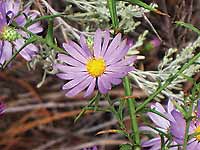 As the ground becomes dryer, the cottonwoods fizzle out, and an abundance of sagebrush covers the landscape. Pinching off a piece I breathe deeply to inhale that pungent, turpentiny scent. This bitter tasting plant is an important browse for pronghorn antelope. The Native Americans used it as a dressing to treat infections as well as a cleansing tonic to expel parasites. As the ground becomes dryer, the cottonwoods fizzle out, and an abundance of sagebrush covers the landscape. Pinching off a piece I breathe deeply to inhale that pungent, turpentiny scent. This bitter tasting plant is an important browse for pronghorn antelope. The Native Americans used it as a dressing to treat infections as well as a cleansing tonic to expel parasites.
I’m almost a mile in to my walk when under the watchful eye of the Monitor and Merrimac formations; I decide to follow the left fork of the canyon. Now the dryness gradually switches back to dampness, and where the tall six-foot grass and other lush vegetation grow, the water often flows. Today, however, due to the cyclic ebb of precipitation I find the pools and stream disappointingly bone dry. But when the rains do return, a bubbling stream will fill those scalloped pools to the brim as rivulets of water drip down the rocky course below.
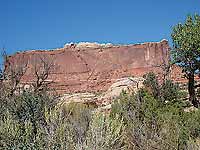 Despite the dry topsoil, the moisture still collects just below the surface, where it quenches the thirst of a forest of willow, Gambels oak, squawbush, and cottonwoods, some of them twisted and bent with old age. Protruding from the ground is an abundance of scouring rush, a leafless, water-loving plant that looks like a field of green knitting needles. Despite the dry topsoil, the moisture still collects just below the surface, where it quenches the thirst of a forest of willow, Gambels oak, squawbush, and cottonwoods, some of them twisted and bent with old age. Protruding from the ground is an abundance of scouring rush, a leafless, water-loving plant that looks like a field of green knitting needles.
As the going gets rougher and thicker with run away growth, I am impressed with all the work it must have taken to build a road to the end of this canyon. Ever so slowly I beat my way through the brush until suddenly I am staring at a steel cable directly in front of me. It follows the canyon floor before going up the wall all the way to the rim. According to excerpts from the book “Day Hikes - #43” by Fran and Terby Barnes, this cable system was apparently used to haul supplies up to the stockmen, who were herding cattle on the mesa above. The authors also mention a trolley car designed to carry those supplies, which I’ve never found – a relic that remains hidden somewhere in the thick undergrowth. The last time I looked down from above, two wooden ladders also remained along the wall, which are best seen from various biking and jeep trails along the rim. Old, weathered and rickety, I certainly wouldn’t trust them now, but back in those days it seems likely the cowboys climbed up and down them to travel back and forth where they spent their wild, off-duty days in the big town of Moab – a feat that would give me a severe case of vertigo! 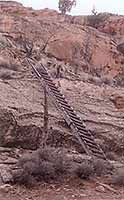
Eventually the faint opening I’ve been following fizzles out, and so do I. The pour-off at the end of this canyon is tantalizingly close, but to make it through this impenetrable jungle, I’d need a machete! I’ve covered approximately three miles, and that’s good enough for me. Now I’m ready for a leisurely lunch as I gaze up at the sharp line created by a penetrating cool blue sky that touches the warm, cinnamon-brown edge of the canyon walls. With the serenity soaking in to me, the birding activity on my outdoor exploration enhances the magic of this canyon: the ravens soaring high above - the screechy call of a house finch - the undulating flight of a flicker - the bubbly chatter of the tiny bushtits - and the flashy blueness of the scrub jay.
Many years have passed since the placement of those ladders and cable with plenty of wild stories lost to unrecorded history – the missing chapters filled with exciting adventures, hardships and loneliness. Pondering over how it must have been many generations ago, I wish I could zoom back for a peek in to a more rustic, slower paced era. I would be going back to a slice of life when a major highway with automobiles whizzing by all the way to Canyonlands National Park for an easy day’s outing could only be a vision in an old timer’s daydreams.
|